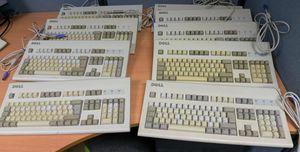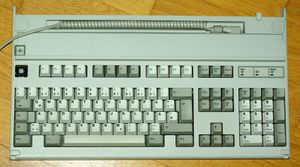Keycap material
| This article requires additional photographic illustration |
Most keycaps, and other keyboard parts, are made from injection-moulding thermoplastic.[Note 1] The process of injection moulding involves melting the plastic using heat and injecting it under pressure into a steel mould where it sets. Depending on the plastic, the keycap will shrink more or less while it cools after demoulding.
Contents
ABS
ABS is an opaque thermoplastic, short for "Acrylonitrile Butadiene Styrene". It is an amorphous polymer comprised of these three monomers, and exists in many different formulations for different applications. Acrylonitrile provides chemical and thermal stability, while Butadiene adds toughness and strength and styrene gives the finished polymer a nice and glossy finish. ABS has high tensile strength and is very resistant to physical impacts and chemical corrosion (except from solvents), which allow the finished plastic to withstand heavy use and adverse environmental conditions.[1] Coupled with its relatively low production costs, this made ABS and other blends with Polystyrene (PS) some of the most commonly used plastics for computer equipment, including keyboard cases.
ABS is the preferred plastic for double-shot molding. That is because most other plastics shrink too much in the moulding process. Legends on ABS keys can also be pad-printed, laser-etched (burned) or laser-engraved (with or without infill). Because of the low shrinkage, some keyboards have space bars made of ABS even if other keys are made of PBT or POM.
Yellowing


ABS (and other polystyrene blends) will gradually turn yellow over time when subjected to ultraviolet light, a component of sunlight.
Yellowing occurs faster if the plastic contains flame-retardant chemicals, but it is more often used in the plastic of keyboard cases than in keys. The IBM Enhanced Keyboard typically used a space bar made of ABS, but sometimes you can find vintage keyboards with a mixture of very yellowed keycaps, and others less yellowed or not yellowed at all. A plausible explanation has been suggested[2] and it goes like thus.
Back in the day, components used in the injection machine were hand-mixed and tossed in the injector's funnel. As some of the pellets in the mix were heavier than others, they would go to the bottom of the funnel due to machine vibration, leaving the lighter ones on top. Also, in order to ensure that the final product had the minimal characteristics expected, the operator would put some "surplus" of flame-retardant in the mix, and since this component was lighter than the pellets, it would tend to stay on top of the funnel, the ending result being pieces where some had more flame-retardant than others, and some might even have none at all.
The main agents triggering the yellowing process are ozone, UV radiation (either by direct sunlight or some lamps), humidity exposure and heat sources. Bad mixed polymers with stabilizing compounds will yellow earlier than others.
Another explanation for specific keycaps being more or less yellowed than others is that they come from a separate batch. A typical example of this are the "F" and "J" keycaps due to the notch or "nub" they have or because they are dished.
Yellowing can be temporarily reversed with the Retr0bright process.
PBT
PBT (short for "polybutylene terephthalate") is one of the hardest, most durable materials for keycaps. It is more resilient against heat and chemicals than ABS, but its properties also make it more difficult to mould, which makes it more uncommon.
Legends on PBT keys are often laser-etched or dye-sublimated but only very rarely double shot moulded. Because of shrinkage during demoulding, PBT is also rarely used for the largest key, the space bar, with a notable exception being Cherry.
PBT does not turn yellow from exposure to ultraviolet light like ABS does. The resilience against heat makes it a good candidate for dyeing in a hot dye bath.
PBT keys are found on the IBM Model M, many vintage Apple Macintosh keyboards, NMB "Space Invader"-switch keyboards, Topre Realforce keyboards (not RGB) and on all contemporary grey and some vintage beige/grey keyboards from Cherry in the G80 and G81 series.
Leopold has also made keyboards and keycap sets with them, with pad-printed or double-shot legends. Some modern gaming keyboards also come with PBT keycaps, but they are considered a premium feature and is not the norm.
Gateron manufactures PBT keycap sets in Cherry profile, sold dye-sublimate printed under the EnjoyPBT brand.
Polycarbonate
Polycarbonate (PC) is a tough, optically clear or opaque, biocompatible plastic with good thermal resistance. These properties make it ideal for applications like car headlights, eyeglasses, and medical equipment. PC can be formed by extrusion, blow molding, and thermoforming, however injection molding provides the most flexibility in terms of shape, production quantity, and mechanical and optical properties for high-volume production at a low cost per part. Besides, this process is the same as used in other thermoplastics.[3]
PC is used mostly for keycaps that are clear and transparent. PC does not yellow like polystyrene/ABS and is more impact-resistant than acrylic (PMMA). It is sometimes blended into ABS to make ABS-PC.
Coloured, transparent keycaps made from PC have been made by Signature Plastics.
POM
POM (short for "Polyoxymethylene") is a thermoplastic. It is sometimes called "Acetal" or "Polyacetal". POM is hard and durable but has low friction, being slippery to the touch. It is more dense than PBT and ABS, and keycaps made of POM tend to have a more muted downstroke.
Legends on POM keys are usually laser-engraved, with or without infill.
Keycaps of POM can not be found on many keyboards. Cherry uses it currently for black keys on its contemporary keyboards in the G80 and G81 series.
Sliders in mechanical key switches are often made of POM. The natural unpigmented appearance of POM is translucent white, which can be seen in the slider of Cherry MX Clear. There are technically two variations of POM: homopolymer and copolymer. The homopolymer is somewhat stiffer and stronger but the copolymer is more dimensionally stable and has less friction. Chemical giant DuPont has the popular brand "Delrin" (not to be confused with the keycap manufacturer "Devlin") for the homopolymer form. It is suitable for machining and laser-cutting and has been been used for plates in some custom keyboards.
PVC
PVC (short for "polyvinyl chloride") is a relatively hard, middle-of-the-road plastic used in keycaps. Production of PVC is somewhat environmentally unfriendly and it is therefore not manufactured in some parts of the world.
It is probably the second most common keycap material, after ABS, widely used by Logitech, Dell, HP, and other mass market brands. PVC has average hardness and friction, but is sensitive to high heat, which will warp it.
PVC legends are often pad printed or stickers, due to its wide use in the mass market, though laser printing with infill can also be observed.
Tenite
According to older Cherry catalogues, most of their keycaps are ABS. The 1973, 1974 and 1979 ("1982") US catalogues give the keycaps as two-shot ABS. The 1982 catalogue from Germany however gives the M7 and M9 tall keycaps as two-shot Tenite (written as "TENITE"), with ABS still being used for the low-profile M8 keycaps.
Testing
Water test
Because of the different density of the plastics in comparison to water (specific gravity), PBT caps will usually sink faster to the bottom than ABS caps.
There are some catches with this method. Trapped air bubbles will affect the net density. Because ABS is an alloy that can be blended with different ratios, not all ABS caps have the exact same plastic. If the legends are engraved and filled, the filling material could have a higher density than ABS.
Acetone test
You can test whether a key is ABS by subjecting it (preferably an area inside the key that can not be seen) to a q-tip dipped in acetone; If the plastic smears then it is probably ABS and definitely not PBT or POM.
Yield strength test
Different plastics have different strength and elasticity, so it is possible to exert pressure on a keycap and see how much it deforms or tears.
The image on the right shows an extreme case where the keycap is smashed to bits. This particular test might not always be representative, as it can be influenced by the keycap's construction (i.e. the thickness of the material and internal lattices).
Footnotes
- ↑ A thermoplastic is a plastic that becomes liquid when it reaches its melting point.
References
- ↑ Adreco Plastics — ABS plastic properties Retrieved 2024-05-20.
- ↑ English Amiga Board — Partial yellowing? Posted 2008-06-16. Retrieved 2024-05-20.
- ↑ Xometry — Polycarbonate Injection Molding: Definition, Applications, Process, and Techniques. Dated 2022-11-23. Retrieved 2024-05-20.

